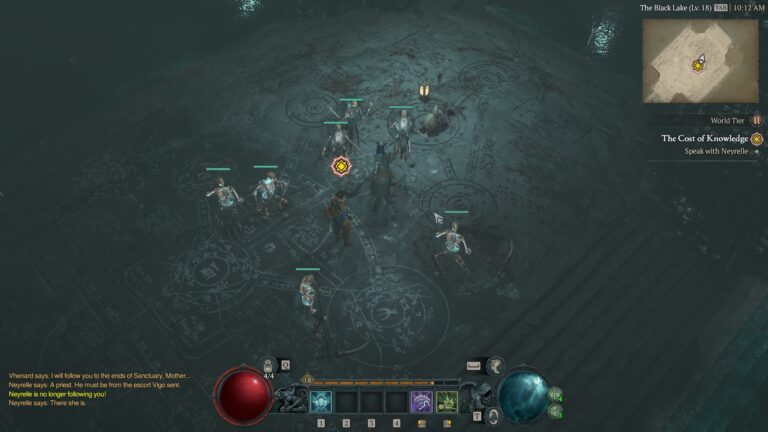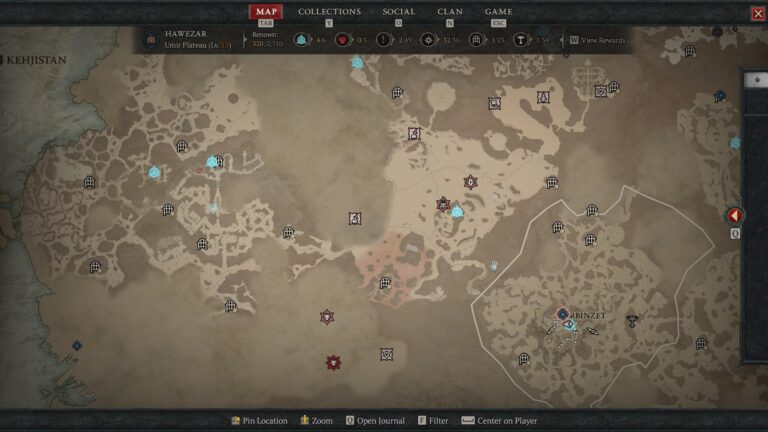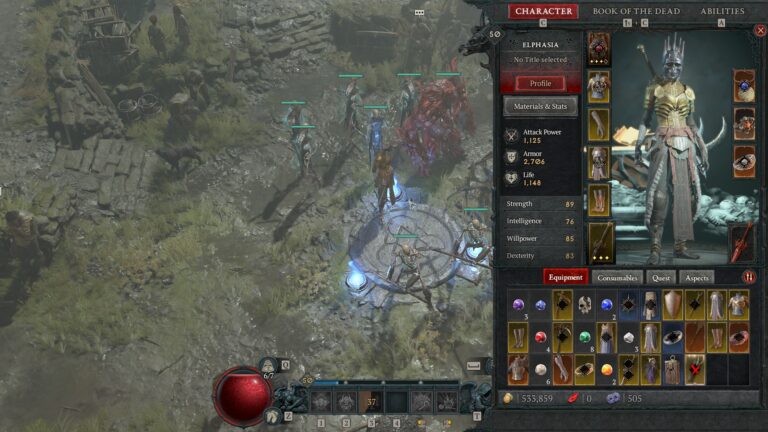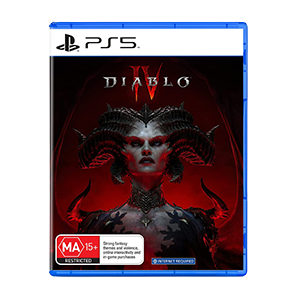Diablo 4 puts a formidable spin on a familiar formula.
Diablo 4 review: The devil in the details
Diablo has a big reputation and a simple formula. You click on your demons until they die. The bigger the monster, the better the rewards.
Over the years, developer Blizzard Entertainment has spiced up that format with fresh reasons to slay monsters, new varieties of foes to face off against and a host of armaments and abilities with which to vanquish them. At this point, series veterans have slashed their way through the hordes of hell more times than they can count. They’ve even done so on mobile via Diablo Immortal.
One of the few things Blizzard hasn’t tried to do with the series at this point is to make it more complicated. Diablo 4 sets out to do just this. If Diablo 3 stripped any possible source of friction, the fourth major instalment in the franchise errs in the opposite direction and finds both value and identity in building things back up.
Quantity can sometimes have a quality of its own and Diablo 4 runs pretty far with that idea. It’s by far the biggest game in the series to date and it's largely successful in its ambitions to offer a different take on the series' occasionally archaic antics.
I can’t say it’s won me over as the definitive demon-slaying dungeon crawler, but there’s a beauty and charm to watching a simple thing you know well morph into something more complicated and unfamiliar.
Diablo 4 review
Where each prior Diablo game has eagerly snapped up the plot threads left hanging by the one that preceded it, Diablo 4 tries to be its own thing.
Set about fifty years after the events of the third game, players take on the role of heroes chasing the trail of a powerful demon named Lilith. As with other games in the series and genre, the most important choice you'll make during character creation is which class you want to play. The five classes to choose from are all returning favourites— Necromancer, Rogue, Sorceress, Barbarian and Druid— none of which have the curveball quality of the Diablo 3 roster.
Still, it’s a decent enough setup for a fantasy hack-and-slash RPG like this one, and there’s something to be said because (aside from the playable classes) so little of what’s here feels referential to previous entries in the series. Instead of leaning on the past, Diablo 4 looks to establish its own cast of heroes, villains, angels and demons. If you're looking for Tyrael and Deckard Cain, you'll be better served by Diablo Immortal or Diablo 2: Remastered.
This broader bent towards originality gives Diablo 4 a freshness that the recent mobile spin-off lacked. That said, the lack of familiar touchstones can also make the narrative here more difficult to grasp and keep up with as the hours drag on. I'm someone who comes to these games as much for the loot as the lore, but even so, it felt like I was being drowned in exposition and cut scenes from time to time.
Diablo 4 genuinely wants you to care about its story, characters and world in a way that previous instalments didn't. That's a bold choice, and I won't be shocked if it proves to be a divisive one once more people have had the chance to play through the game. Even if I didn't really like or care about the story of Diablo 4 all that much, I do really like that the team behind the game had the nerve to try and do something other than what the series has always done and what you'd expect of it.

The other big difference between Diablo 4 and previous games in the series is a structural one. Rather than play through a series of relatively disconnected maps and dungeons, the latest instalment in Blizzard’s hack-and-slasher takes place across one singular-though-not-seamless open world. In many respects, Diablo 4 is looking to make the kind of leap that games like Elden Ring and The Legend of Zelda Breath of the Wild made for their respective franchises.
And to be sure, there’s a definite appeal in the freedom that this gearshift brings with it. Right from the get-go, you can wander in any direction and you’ll find new quests, enemies, loot and locations to explore. Diablo 4 begins in the snowy Fractured Peaks, but it's only one of five major regions you'll trawl over the course of the campaign. Since difficulty scales with your level, there’s no risk of wandering where you shouldn’t and there is a staggering amount to discover across the breadth of Sanctuary.
If the cutscenes in Diablo 4 feel directly informed by what Blizzard did with Starcraft 2, the density of the open world map comes across as descended from World of Warcraft in much the same way. You can even unlock a mount to make wandering the landscape more efficient once you reach the latter stages of the single-player campaign.
If you’re someone who finds satisfaction in the ritual of clearing everything on an in-game map, Diablo 4 will give you plenty to do. Most of the side quests aren’t particularly involved or time intensive, but there are a lot of them. There’s rarely anything as rote as being asked to kill 20 boars, but what’s here isn’t usually that much more involved. More often than not, these endeavours usually have some sort of Witcher-inspired narrative hook that adds colour and context to the violence you'll have to enact along the way.
Unfortunately, the sheer volume of side gigs and other objectives on the map sometimes makes the experience of playing Diablo 4 feel a bit more like a chore than it should. Where Diablo 3 and other games in the series have kept their focus on one or two plot threads at a time, my quest log in this instalment swelled to the point where it felt unmanageable and overwhelming well before I had left even the first region. Giving you more things to do also increases the opportunity cost of trying a new class, which runs against the way that these games are typically played.

At times, the amount of clutter inevitably weighs down the action. Diablo 4 doesn’t feel that much more sluggish than Diablo 3 but it does feel slower. If that game was all about providing a second-to-second sense of satisfaction, this one feels more inclined towards longer gameplay loops and a deeper arc of character progression.
To that end, the skill rune system from Diablo 3 is nowhere to be seen. Instead, a reworked talent tree and paragon point loom large in its absence. Likewise, the crafting system introduced in the last game has been traded out for a more streamlined setup where you can scrap items into resources that can then be used to upgrade the gear you’re currently using.
The potion system has also been similarly tweaked to be more akin to the Estus Flask in Dark Souls. Resources can be collected to upgrade your healing potions and completing regional objectives will allow you to carry more of them at a time. This is complemented by a bespoke alchemy mechanic that allows you to brew up potions and elixirs designed to increase your effectiveness against specific types of monsters.
All of this is to say that Diablo 4 does a lot of things very differently, even if the core loop — clicking on enemies until they die and the loot pops out — isn’t all that much of a departure from what’s come before. The sum of these parts doesn’t make for anything more than what you’d expect, but it does lend the game a sense of character that contrasts against the rest of the series.
Diablo 4 rarely feels like just another one of these, and I mostly mean that in a positive sense. If the ambition was to make a Diablo game that felt different, it's an overwhelming success. It zigs in every way that its predecessor zags.
When your core gameplay loop is so simple, the magic of what makes a good hack-and-slash game has more to do with how that action is framed and paced. For a game like this, the structure can matter as much as the systems do and the freshness of the open world in Diablo 4 makes it compelling and unknown in a way that draws you in.
Discovering what makes Diablo 4 different is one of its highlights. It's buoyed by novelty, though sometimes bogged down in the details by comparison to that which came before it.
Is Diablo 4 worth buying?

Despite my quibbles about Diablo 4, I will happily admit that I played a truly hideous amount of it over the course of this review. For all my niggles about the narrative, I did manage to see the story in the game through to its conclusion. I've got plenty of notes about the character progression systems in the game, but I am already itching to roll a new class and do it again in co-op.
Many of my complaints are the kind of critiques that only someone who has played way too much Diablo can express. That said, the fact that so much of what’s here is authored rather than algorithmic has me worried that Diablo 4 may not command the staying power and replay value that Diablo 2 and Diablo 3 do. Both of those games are really smart about disguising the at-times dated and shallow design choices they make by being really good at making each run feel different.
Each Diablo game has inspired its own generation of diehards and I suspect that this one will continue that trend. The open world here is staggeringly large but significantly more suited for completionists who want to see everything in a single run than previous instalments in the series.
Right now, Diablo 4 ditches the leanness of its predecessor in ways that are surprising and satisfying, but rarely superior. It's enticing to watch a simple thing be complicated, though sometimes the sum of that spectacle is a reminder that less can sometimes be more.
Diablo 4 trailer
What can I play Diablo 4 on?
Diablo 4 is available for PlayStation 5, Xbox Series X|S and PC.
Does Diablo 4 have cross save?
In Diablo 4, your characters and progress are tied to your Battle.Net account. So long as you use the same login between the PC, PS5 and Xbox versions of the game you should be able to carry your progress and loot from one platform to another.
Is Diablo 4 coming to the Switch
At the time of writing, Diablo 4 is not coming to Nintendo Switch. It's possible that a port of the game might be announced at a later date, but given the increased fidelity of the fourth installment in the series it might not be worth getting your hopes up.
Related Articles





